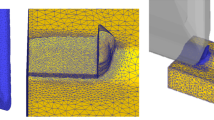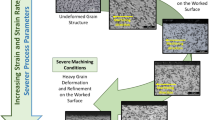Abstract
It has been well documented in the literature the importance of strict surface integrity checks upon performance and quality of machined components, especially for the safety critical components (e.g., aerospace) that work at cyclic high mechanical loads and elevated temperatures. In this field, Waspaloy, within the commercially available nickel-based superalloys, is extensively applied in different industries such as aircraft, chemical plant equipment, and petrochemical equipment. The main objective of this paper is to implement a reliable FE model, for dry orthogonal machining of Waspaloy, capable to predict microstructural changes and dynamic recrystallization during the cutting process. A user subroutine was implemented in FE code to simulate the dynamic recrystallization and consequently grain refinement and hardness variation on the machined surface and below it. Zener–Hollomon (Z-H) and Hall–Petch (H-P) equations were employed to, respectively, predict grain size and microhardness. In addition, depth of the affected layer was controlled using the critical strain equation. FE numerical model was properly calibrated using an iterative procedure based on the comparison between simulated and experimental results. Finally, very good agreement was found between experimental and simulated results of grain size, microhardness, depth of the affected layer, and other fundamental variables such as cutting forces, temperature, and chip morphology.
Similar content being viewed by others

References
Miller S (1996) Advanced materials means advanced engines. Interdscip Sci Rev 21(2):117–129
Choudhury IA, El-Baradie MA (1998) Machinability of nickel-base super alloys: a general review. J Mater Proc Technol 74:278–284
Ezugwu EO (2005) Key improvements in the machining of difficult-to-cut aerospace superalloys. Int J Mach Tools Manuf 45(12–13):1353–1367
Ezugwu EO, Bonney J, Yamane Y (2003) An overview of the machinability of aeroengine alloys. J Mater Proc Technol 134(2):233–253
Agrawal A, Goel S, Rashid WB, Price M (2015) Prediction of surface roughness during hard turning of AISI 4340 steel (69 HRC). Appl Soft Comput 30:279–286
Jafarian F, Imaz Ciaran M, Umbrello D, Arrazola PJ, Filice L, Amirabadi H (2014) Finite element simulation of machining Inconel 718 alloy including microstructure changes. Int J Mech Sci 88:110–121
Rotella G, Dillon OW Jr, Umbrello D, Settineri L, Jawahir IS (2013) Finite element modeling of microstructural changes in turning of AA7075-T651. J Manuf Proc 15:87–95
Jawahir IS, Brinksmeier E, M’Saoubi R, Aspinwall DK, Outeiro JC, Meyer D (2011) Surface integrity in material removal processes: recent advances. Ann CIRP Manuf Technol 60(2):603–626
Axinte DA, Dewes RC (2002) Surface integrity of hot work tool steel after high speed milling: experimental data and empirical models. J Mater Proc Technol 127(3):325–335
Thomas JP, Montheillet F, Semiatin SL (2007) A geometric framework for mesoscale models of recrystallization. Metall Mater Trans A 38:2095–2109
Sommitsch C, Mitter W (2006) Acta Mater 54:357–375
Calamaz M, Coupard D, Girot F (2008) A new material model for 2D numerical simulation of serrated chip formation when machining titanium alloy Ti-6Al-4V. Int J Mach Tools & Manuf 48:275–288
Sima M, Ozel T (2010) Modified material constitutive models for serrated chip formation simulations and experimental validation in machining of titanium. Int J Mach Tools Manuf 50(11):943–960
Wang B, Liu Z (2015) Shear localization sensitivity analysis for Johnson–Cook constitutive parameters on serrated chips in high speed machining of Ti6Al4V. Simul Model Pract Theory 55:63–76
Shrot A, Baker M (2015) Determination of Johnson–Cook parameters from machining simulations. Comput Mater Sci 52(1):298–304
Ljustina G, Larsson R, Fagerstrom M (2014) A FE based machining simulation methodology accounting for cast iron microstructure. Finite Elem Anal Des 80:1–10
Umbrello D, M’Saoubi R, Outeiro JC (2007) The influence of Johnson-Cook material constants on finite element simulation of machining of AISI 316L steel. Int J Mach Tools Manuf 47(3–4):462–470
Arrazola PJ, Özel T, Umbrello D, Davies M, Jawahir IS (2013) Recent advances in modelling of metal machining processes. CIRP Ann Manuf Technol 62(2):695–718
ASTM E112—12 standard test methods for determining average grain size.
Deform® user manual. Columbus, OH, USA: SFTC-Deform; 2010.
Rotella G, Umbrello D (2014) Numerical simulation of surface modification in dry and cryogenic machining of AA7075 alloy. Procedia CIRP 13:327–332
Zhou L, Liu G, Han Z, Lu K (2008) Grain size effect on wear resistance of a nanostructured AISI 52100 steel. Scripta Mater 58:445–448
Ho HS, Risbet M, Feaugas X, Moulin G (2011) Damage mechanism related to localization of plastic deformation of WaspaloyTM: effect of grain size. Proc Eng 10:863–868
Del Prete A, Filice L, Umbrello D (2013) Numerical simulation of machining nickel-based alloys. Procedia CIRP 8:539–544
Rotella G, Umbrello D (2014) Finite element modeling of microstructural changes in dry and cryogenic cutting of Ti6Al4V alloy. Ann CIRP Manuf Technol 63:69–72
Thomas JP, Montheillet F, Semiatin SL ‘Modeling of microstructure evolution during the thermomechanical processing of nickel-base superalloys’, ASM Handbook: Fundamentals of Modeling for Metals Processing, 22, 566–582
Tsuji N, Maki T (2009) Enhanced structural refinement by combining phase transformation and plastic deformation in steels. Scripta Mater 60/12:1044–1049
Shen G, Semiatin SL, Shivpuri R (1995) Modeling microstructural development during the forging of Waspaloy. Metal Mater Trans A 26:1795–1803
Author information
Authors and Affiliations
Corresponding author
Rights and permissions
About this article
Cite this article
Caruso, S., Imbrogno, S., Rinaldi, S. et al. Finite element modeling of microstructural changes in Waspaloy dry machining. Int J Adv Manuf Technol 89, 227–240 (2017). https://doi.org/10.1007/s00170-016-9037-y
Received:
Accepted:
Published:
Issue Date:
DOI: https://doi.org/10.1007/s00170-016-9037-y



